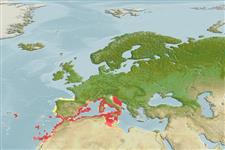Common names from other countries
>
Anguilliformes (Eels and morays) >
Ophichthidae (Snake eels) > Ophichthinae
Etymology: Apterichtus: From the Greek απτερόν (apteron), without fins, and ίχθύς (ichtus, more correctly written ichthys; masculine), fish..
More on author: Peters.
Environment: milieu / climate zone / depth range / distribution range
Écologie
marin démersal; profondeur 10 - 250 m (Ref. 101270). Subtropical; 45°N - 20°N, 26°W - 17°E
Eastern Atlantic: Mediterranean coast of Israel; from Utica Island, southern Tyrrhenian Sea;, from Madeira, the Canary and Cape Verde Islands; possibly from Angola.
Taille / Poids / Âge
Maturity: Lm ? range ? - ? cm
Max length : 49.3 cm TL mâle / non sexé; (Ref. 4455)
Description synthétique
Clés d'identification | Morphologie | Morphométrie
Vertèbres: 150 - 157. This species is distinguished by the following characters: tail 1.8-2.0 in TL; head 14-16 in TL; body depth 59-100 in TL; preopercular pores 3; supratemporal canal with 3 pores; conical teeth, uniserial on jaws and vomer; vomerine teeth 2-4; coloration reddish or brownish, tip of jaws black, belly whitish; sometimes a large number of small darker patches on back and upper side; MVF 73-154, total vertebrae 150-157(n=8). (Ref. 101270).
Burrows in sand or mud on the continental shelf (Ref. 4455).
Life cycle and mating behavior
Maturities | Reproduction | Spawnings | Egg(s) | Fecundities | Larves
Distinct pairing (Ref. 205).
McCosker, J.E. and Y. Hibino, 2015. A review of the finless snake eels of the genus Apterichtus (Anguilliformes: Ophichthidae), with the description of five new species. Zootaxa 3941(1):49-78. (Ref. 101270)
Statut dans la liste rouge de l'IUCN (Ref. 130435)
CITES (Ref. 128078)
Not Evaluated
Menace pour l'homme
Harmless
Utilisations par l'homme
Outils
Articles particuliers
Télécharger en XML
Sources Internet
Estimates based on models
Preferred temperature (Ref.
115969): 16.1 - 21, mean 19.3 (based on 52 cells).
Phylogenetic diversity index (Ref.
82804): PD
50 = 0.5000 [Uniqueness, from 0.5 = low to 2.0 = high].
Bayesian length-weight: a=0.00089 (0.00039 - 0.00204), b=3.00 (2.80 - 3.20), in cm Total Length, based on LWR estimates for this (Sub)family-body shape (Ref.
93245).
Niveau trophique (Ref.
69278): 4.0 ±0.7 se; based on size and trophs of closest relatives
Résilience (Ref.
120179): Haut, temps minimum de doublement de population inférieur à 15 mois (Preliminary K or Fecundity.).
Fishing Vulnerability (Ref.
59153): Moderate vulnerability (39 of 100).
